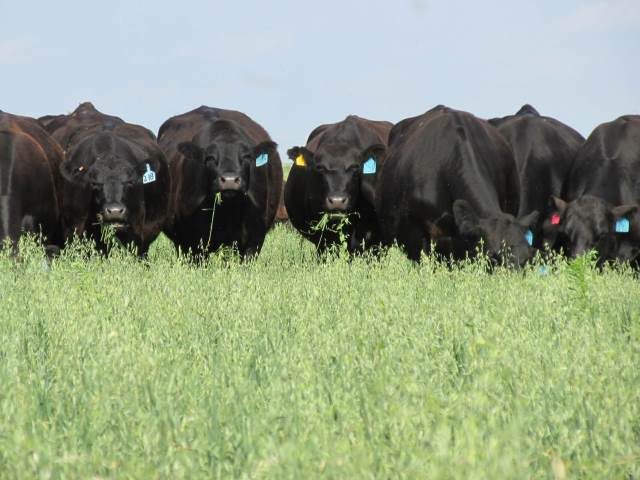As fields start to green up from last fall’s cover crops, cattle producers can’t wait to get cows out of calving yards and onto fresh grass. Denise Schwab, Iowa State University Extension beef specialist, offers five tips when grazing cover crops.
1. How long do you want the forage to last?
If you want to terminate in a short time, graze as soon as it greens up. If you want some substantial grazing, wait until forage is about 6” tall to start. Typically, cereal rye will be the first forage to break dormancy, followed a week or two later by triticale and wheat. Giving forage time to get established results in more season-long growth, but graze early to prevent it from getting ahead of the cows.
2. Transition the diet.
Nothing is worse on the rumen than an abrupt change from a dry forage and grain diet to a wet, high protein forage only diet. The rumen microbes need time to adjust to diet changes. Spring cover crops are both high in protein (13-19% CP) and high in water content resulting in a fast passage rate. The energy content tends to be fairly high (55-60%TDN) but because of the high water content it is a challenge for the cow to meet her energy and dry matter intake needs. Continue to supplement your dry forage diet while the cows are grazing cover crops, just cut back on the quantity fed, or provide free choice dry hay as a supplement. However, supplementing other feed in many cases is not practical since cows generally are not very interested in stored feed once they are turned onto cover crops. The best compromise may be to fill up the cows on their existing ration before turning them out for the first time this spring and allow their gut fill to regulate how much they consume initially.
3. Have a sacrifice paddock or dry lot in case of heavy rain.
Typical spring grazing should not negatively impact grain yields, and in some cases actually increase yields. However, excessive hoof traffic during extremely wet weather may cause compaction, the need to smooth the surface, or to do mild tillage. Move water and mineral sites regularly to reduce congregation areas. Consider strip-grazing to both increase forage utilization and to reduce the risk of compaction when raining. When heavy rain or a long stretch of rain occurs, move cows off the field.
4. Beware of grass tetany and nitrate risk.
Grass tetany is a risk any time cows are grazing lush spring forages which are high in protein, moisture and potassium, and low in magnesium, calcium and sodium. Feed a high magnesium mineral for a week or two prior to turnout to reduce the risk of grass tetany. Supplementing dry forage, if cows will eat it, can help to both slow the rate of passage through the digestive system and dilute the low-mineral grass with higher mineral dry forage. Grasses, including cover crops, are good at scavenging nitrogen from the soil to produce leaf tissue and grain. Cover crops heavily fertilized, manured, or following a drought may accumulate nitrates which can be toxic in the cow. Because nitrates tend to concentrate in the lower part of the plant, use rotational grazing to leave more residue, along with supplemental dry forages to reduce the risk of nitrate toxicity.
5. Termination of the cover crop.
Remember that the cover crop needs to have green growing leaf tissue for contact herbicides to work. Plan for 1-2 weeks of regrowth after grazing before herbicide application to be effective.





Post a comment
Report Abusive Comment